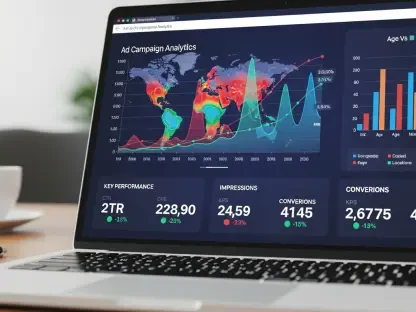Imagine a world where asking a complex question to a digital assistant yields not just a list of links, but a concise, human-like response tailored to your exact needs, transforming the way we interact with technology. This is no longer a distant vision but a reality shaped by Large Language Models (LLMs), the backbone of modern conversational AI systems. These advanced technologies have redefined how information is accessed, processed, and delivered, impacting everything from search engines to customer service platforms. This review dives deep into the mechanisms, applications, and implications of LLMs, exploring their transformative role in the digital landscape as of 2025.
Core Features and Performance of LLMs
Natural Language Understanding and Generation
At the heart of LLMs lies their remarkable ability to comprehend and produce human-like text, a feat achieved through training on massive datasets encompassing diverse linguistic patterns. These models analyze input queries with a nuanced grasp of syntax and semantics, enabling them to generate responses that often mimic natural conversation. This capability has made platforms powered by LLMs indispensable for users seeking quick, synthesized answers without sifting through traditional search results.
Beyond mere text generation, the performance of LLMs is evident in their capacity to adapt to varied tones and contexts, whether drafting professional emails or crafting creative narratives. Their training data, often spanning billions of words, equips them to handle intricate queries with a level of fluency that sets them apart from earlier AI systems. This adaptability underscores their growing relevance across multiple domains, from education to entertainment.
Entity Recognition and Contextual Analysis
Another defining feature of LLMs is their shift away from keyword-centric processing toward entity recognition, focusing on specific people, places, or concepts. This approach allows them to prioritize context over isolated terms, delivering answers that align closely with user intent. By mapping relationships between entities, LLMs create interconnected content clusters that enhance the relevance of their outputs.
This contextual prioritization has revolutionized content optimization, as businesses now aim to be recognized as authoritative sources within these entity networks. Performance metrics show that content structured with clear entity associations often ranks higher in AI-generated responses, highlighting a significant departure from traditional search engine strategies. The impact on digital visibility is profound, pushing creators to rethink how information is presented and linked.
Emerging Trends in LLM Technology
One of the most notable trends in LLM development is the rise of multimodal capabilities, where these models process not just text but also images, videos, and audio inputs. This integration enables richer, more dynamic interactions, such as describing visual content or summarizing multimedia data in real time. As a result, user experiences are becoming more seamless, with AI systems offering holistic responses across formats.
Additionally, the concept of “LLM visibility” has emerged as a critical metric, measuring how frequently content or brands are cited in AI responses. Industry data indicates a growing reliance on Generative Engine Optimization (GEO), a strategy focused on tailoring content for AI parsing rather than traditional search algorithms. This shift reflects a broader movement toward AI-driven discovery, with projections suggesting significant growth in search revenue influenced by these models over the next few years, up to 2027.
The rapid adoption of LLMs also brings attention to evolving user behaviors, as conversational AI becomes the preferred mode of information retrieval. Businesses are increasingly investing in tools to track AI citations and optimize for natural language queries, ensuring their content aligns with how these models interpret and prioritize information. This trend signals a fundamental change in the digital ecosystem, where adaptability to AI frameworks is paramount.
Real-World Applications in Digital Ecosystems
In practical settings, LLMs have proven instrumental in industries like e-commerce, where aligning product descriptions with user intent through natural language processing boosts engagement and sales. Retail platforms leverage these models to power chatbots that handle customer inquiries with precision, often resolving issues faster than human agents. Such implementations demonstrate the tangible benefits of integrating AI into customer-facing operations.
Similarly, software-as-a-service (SaaS) companies utilize LLMs to enhance user onboarding and support, crafting personalized tutorials or troubleshooting guides based on individual queries. By embedding structured data like schema markup, these businesses improve their visibility in AI-generated overviews, ensuring their solutions are readily surfaced. Case studies from leading SaaS providers reveal up to a 30% increase in discoverability through such targeted strategies.
Beyond commerce, educational platforms harness LLMs to create adaptive learning materials that respond to student needs in real time. These applications not only streamline content delivery but also foster interactive environments where complex topics are broken down into digestible explanations. The versatility of LLMs in addressing diverse sector-specific challenges highlights their role as a cornerstone of modern digital strategy.
Challenges and Ethical Implications
Despite their advancements, LLMs face significant technical hurdles, such as the occurrence of AI hallucinations—instances where models generate inaccurate or fabricated information. This issue poses risks to credibility, especially when users rely on AI responses for critical decisions. Addressing these inaccuracies requires ongoing refinement of training datasets and validation mechanisms to ensure output reliability.
Ethical concerns also loom large, particularly around biased citations and the potential perpetuation of misinformation. The integrity of content surfaced by LLMs must adhere to established frameworks like Google’s E-E-A-T principles, which emphasize experience, expertise, authoritativeness, and trustworthiness. Balancing visibility with authenticity remains a pressing challenge for developers and content creators alike.
Moreover, the energy-intensive nature of training and deploying LLMs raises environmental questions, prompting discussions on sustainable AI practices. As adoption scales, stakeholders must navigate these multifaceted issues, ensuring that innovation does not come at the expense of ethical standards or ecological responsibility. Transparent guidelines and accountability measures are essential to mitigate these risks.
Future Outlook and Strategic Considerations
Looking ahead, LLMs are poised for breakthroughs in deeper multimodal integration, potentially transforming how search and discovery operate across digital platforms. Enhanced processing of diverse data types could lead to even more intuitive AI assistants capable of handling complex, multifaceted tasks. This trajectory suggests a future where AI becomes an invisible yet integral part of daily interactions.
The long-term impact on businesses will likely involve a redefinition of digital presence, with an emphasis on creating content ecosystems that resonate with AI interpretation. Predictions point to an increased convergence of AI tools within everyday applications, reshaping user expectations and competitive landscapes. Staying ahead will demand continuous investment in understanding and leveraging these evolving capabilities.
Furthermore, the broadening scope of LLM applications may influence policy and regulation, as governments and organizations grapple with ensuring fair and safe usage. The potential for these models to shape societal narratives underscores the need for robust oversight and proactive adaptation. As the technology matures, its integration into global systems will require careful calibration to maximize benefits while minimizing disruptions.
Final Thoughts and Next Steps
Reflecting on this exploration of Large Language Models, it is clear that their influence has already reshaped the digital terrain by 2025, offering unparalleled capabilities in natural language processing and beyond. Their performance in real-world applications has demonstrated significant value, though not without notable challenges in accuracy and ethics. The journey of LLMs stands as a testament to rapid technological progress, setting a high bar for what AI can achieve.
Moving forward, businesses and developers should prioritize the development of hybrid strategies that blend traditional digital practices with AI-specific optimizations. Investing in tools to monitor LLM visibility and refine content for entity recognition will be crucial steps to maintain relevance. Additionally, advocating for ethical guidelines and sustainable practices can ensure that innovation aligns with societal good.
As a final consideration, fostering collaboration across industries to share best practices and address common pitfalls will pave the way for a more inclusive AI-driven future. Emphasizing education on LLM capabilities and limitations among end-users can further enhance trust and adoption. These actionable measures offer a path to harness the full potential of LLMs, ensuring they serve as tools for empowerment rather than sources of uncertainty.









